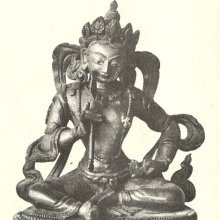Shankhapadma, Śaṅkhapadma, Śaṃkhapadma, Shankha-padma, Shamkha-padma, Shamkhapadma: 2 definitions
Introduction:
Shankhapadma means something in Hinduism, Sanskrit. If you want to know the exact meaning, history, etymology or English translation of this term then check out the descriptions on this page. Add your comment or reference to a book if you want to contribute to this summary article.
The Sanskrit terms Śaṅkhapadma and Śaṃkhapadma can be transliterated into English as Sankhapadma or Shankhapadma or Samkhapadma or Shamkhapadma, using the IAST transliteration scheme (?).
Images (photo gallery)
In Hinduism
Purana and Itihasa (epic history)
Source: Cologne Digital Sanskrit Dictionaries: The Purana IndexŚaṅkhapadma (शङ्खपद्म).—Royal symbols in the arms of a cakravartin.*
- * Brahmāṇḍa-purāṇa II. 29. 86; Vāyu-purāṇa 57. 79.

The Purana (पुराण, purāṇas) refers to Sanskrit literature preserving ancient India’s vast cultural history, including historical legends, religious ceremonies, various arts and sciences. The eighteen mahapuranas total over 400,000 shlokas (metrical couplets) and date to at least several centuries BCE.
Shaivism (Shaiva philosophy)
Source: SOAS University of London: Protective Rites in the Netra TantraŚaṃkhapadma (शंखपद्म) refers to a “conch and lotus”, according to the Netratantra of Kṣemarāja: a Śaiva text from the 9th century in which Śiva (Bhairava) teaches Pārvatī topics such as metaphysics, cosmology, and soteriology.—Accordingly, [verse 18.63-68, while describing the iconography of Mṛtyujit and the consort Amṛtalakṣmī]—“After [the Mantrin] has meditated on the beautiful form as indicated earlier, he should worship Mṛtyujit and Śrī Devī [Amṛtalakṣmī], [...]. She is charming [and] wears a pure white crown. [She has] one face, three eyes, [and is] seated in the baddhapadmāsana, adorned with a Yoga strap, a conch and lotus in [her] hand (śaṃkhapadma-karā), the hands [forming the gestures of] wish-granting and protection. Four armed, Mahādevī is marked with all auspicious signs. [...]”.

Shaiva (शैव, śaiva) or Shaivism (śaivism) represents a tradition of Hinduism worshiping Shiva as the supreme being. Closely related to Shaktism, Shaiva literature includes a range of scriptures, including Tantras, while the root of this tradition may be traced back to the ancient Vedas.
See also (Relevant definitions)
Partial matches: Shankha, Padma.
Starts with: Shankhapadmakadi.
Full-text: Dvadashamurti, Madhusudana, Padmanabha, Damodara.
Relevant text
Search found 6 books and stories containing Shankhapadma, Śaṅkhapadma, Śaṃkhapadma, Shankha-padma, Shamkha-padma, Shamkhapadma, Sankhapadma, Śaṃkha-padma, Śaṅkha-padma, Samkhapadma, Samkha-padma, Sankha-padma; (plurals include: Shankhapadmas, Śaṅkhapadmas, Śaṃkhapadmas, padmas, Shamkhapadmas, Sankhapadmas, Samkhapadmas). You can also click to the full overview containing English textual excerpts. Below are direct links for the most relevant articles:
Animal Kingdom (Tiryak) in Epics (by Saranya P.S)
Lalitopakhyana (Lalita Mahatmya) (by G.V. Tagare)
Manasara (English translation) (by Prasanna Kumar Acharya)
The Garuda Purana (by Manmatha Nath Dutt)
Chapter CXXIX - The Pratipad Vratas < [Brihaspati (Nitisara) Samhita]
The Skanda Purana (by G. V. Tagare)
Chapter 61 - The Greatness of Vaiṣṇava Tīrthas < [Section 2 - Uttarārdha]
Chapter 14 - The Marriage Festival of Lakṣmī and Nārāyaṇa < [Section 9 - Vāsudeva-māhātmya]
The Padma Purana (by N.A. Deshpande)
Chapter 228 - Description of the Highest Heaven etc. < [Section 6 - Uttara-Khaṇḍa (Concluding Section)]
